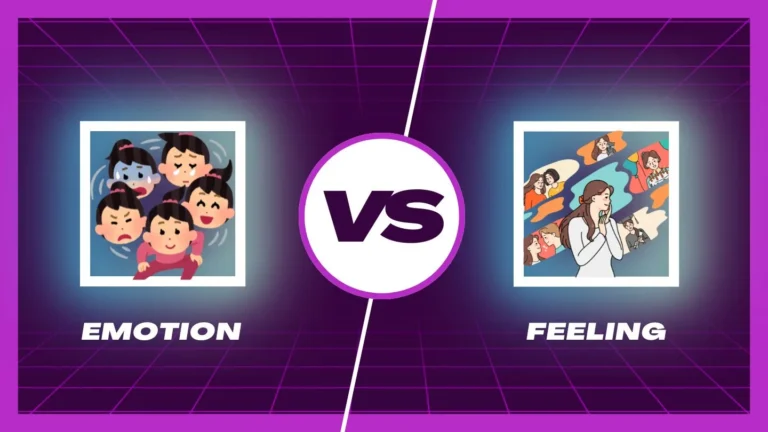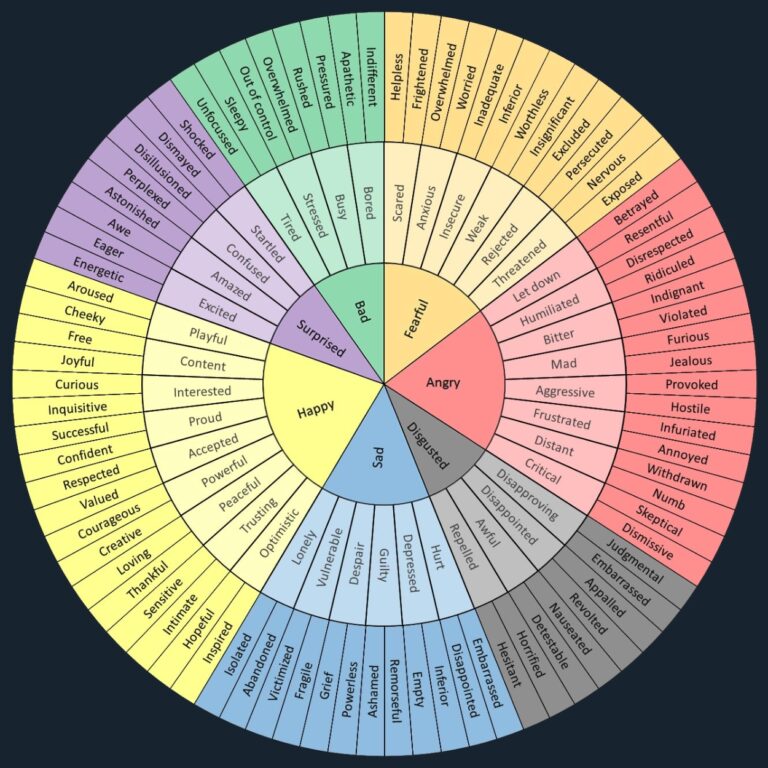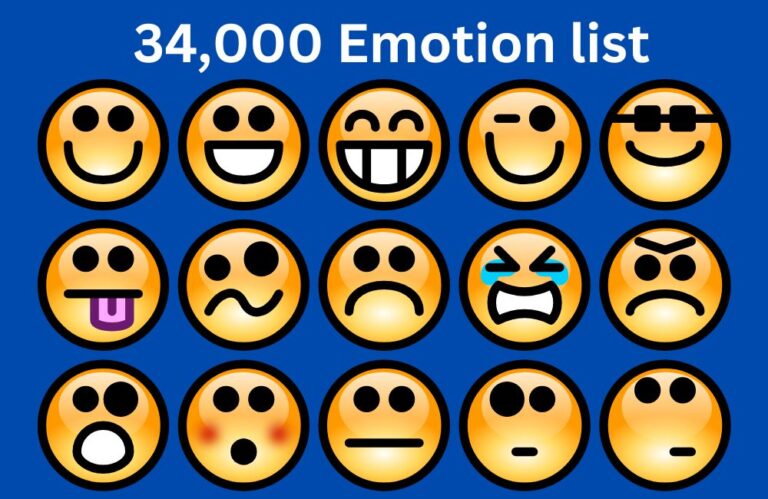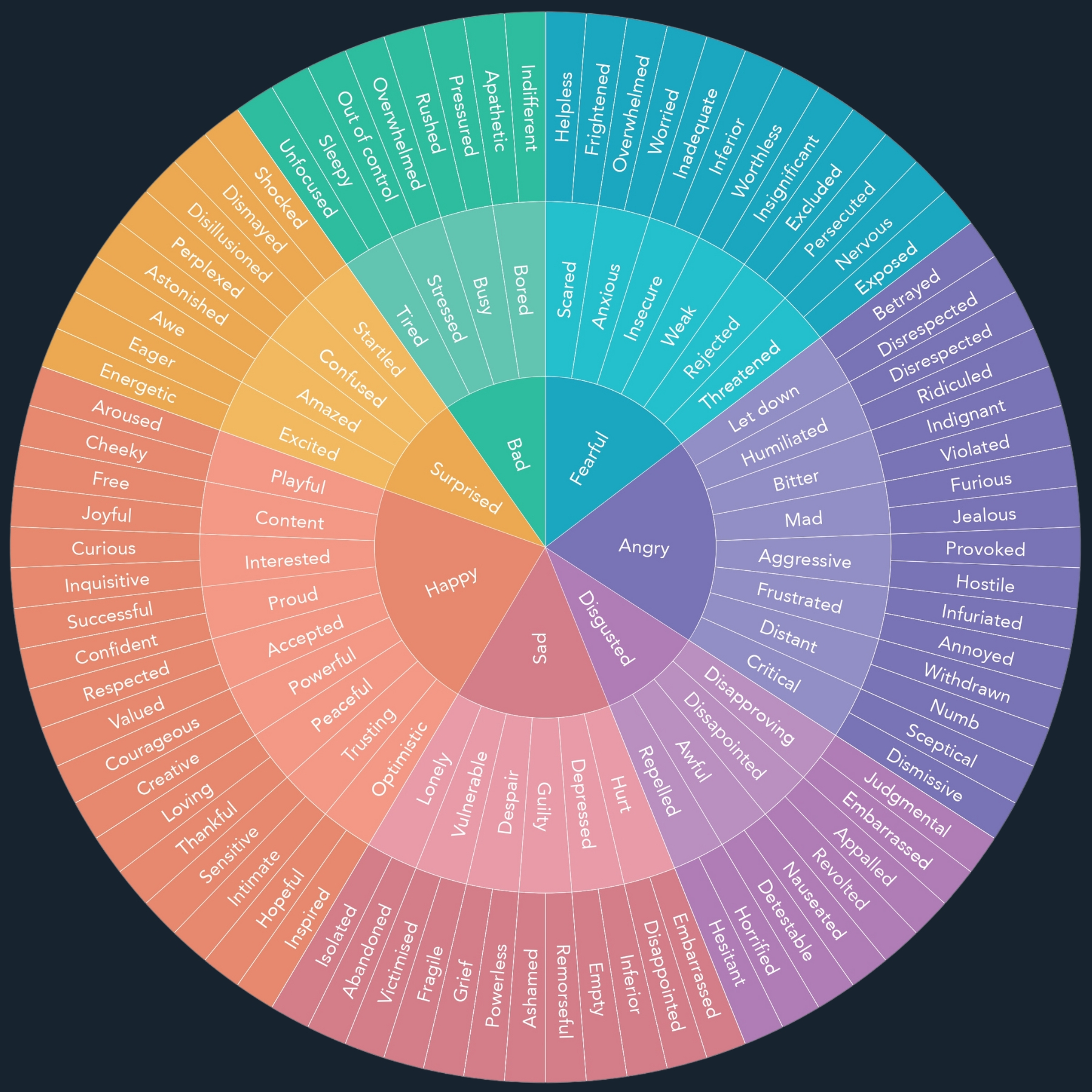
Have you ever found it difficult to put your feelings into words? Emotions can be complicated and hard to pinpoint. This is where a feelings wheel becomes invaluable. A feelings wheel is a tool that helps you identify and express your emotions more accurately, boosting your emotional awareness.
Recognizing and expressing our emotions is vital for mental health and overall well-being. With the help of a feelings wheel you can enhance your communication, manage your emotions more effectively, and make better decisions.
In this blog post, we will delve into what a feelings wheel is explore its benefits, and discuss how you can use it daily to improve your emotional intelligence.
Read More – Plutchik’s Wheel of Emotions: Feelings Wheel
What is a Feelings Wheel? – emotional wheel
The feelings wheel is an effective instrument intended to make you aware of and self-monitor your emotions. Usually, it is a round chart divided into several parts that symbolize diverse feelings.
It helps you experience your emotional space better to have improved emotional intelligence. The idea behind it is the merging of psychology, neuroscience, and linguistics according to Gloria Wilcox.
There are three layers in the Feelings Wheel; primary, secondary, and tertiary emotions. The inner circle has basic emotions such as happiness or sadness.
As one moves outwards, more specific feelings come into play giving you a clearer idea of how you feel emotionally.
It is an excellent tool when you feel overwhelmed or during difficult conversations leading to better management of your emotions and improved expression thereof.
How does the Feelings Wheel work?
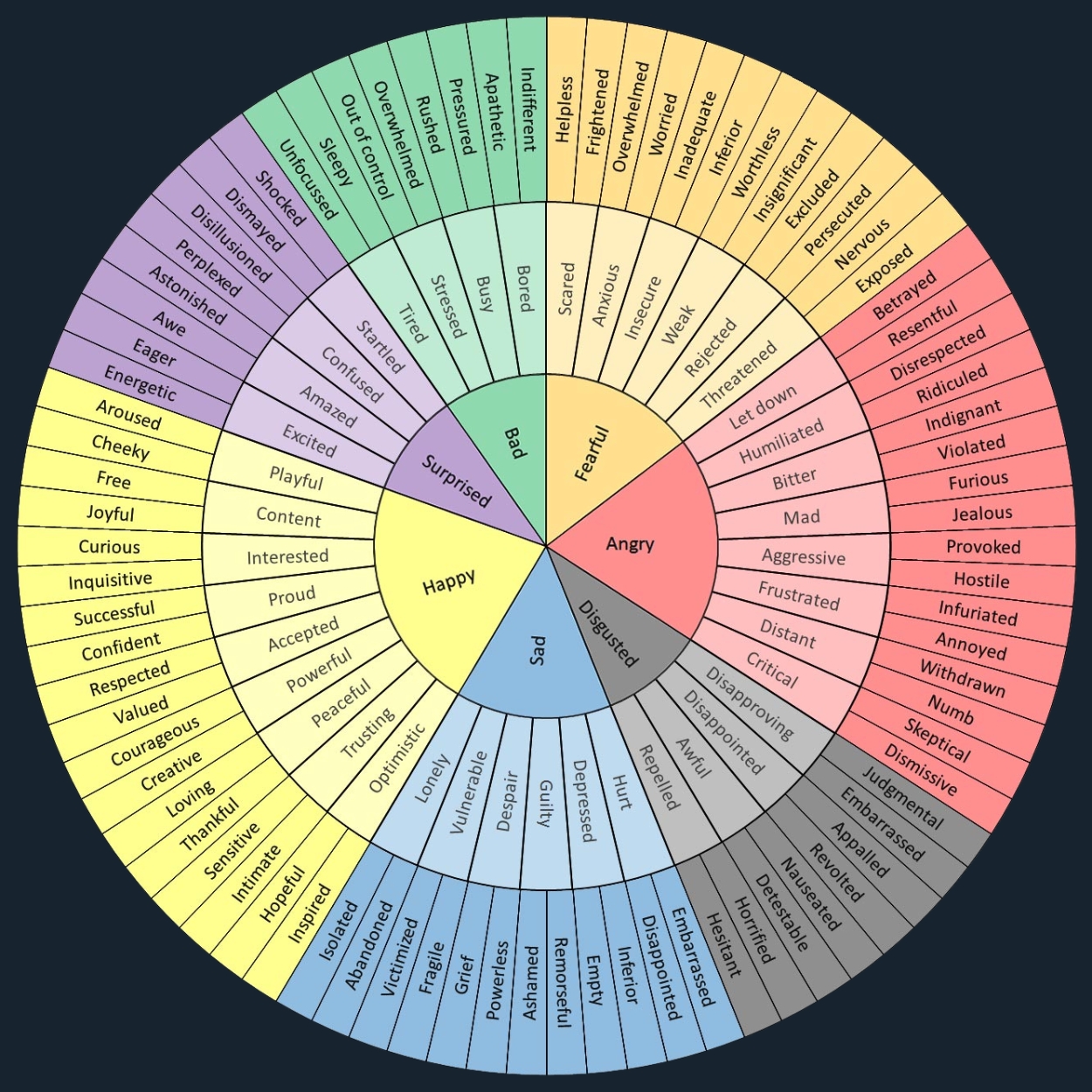
The Feelings Wheel is a valuable tool that organizes our emotions into various categories and subcategories, helping us identify exactly how we feel. This can be especially useful when emotions are overwhelming or during intense conversations.
At a glance, the Feelings Wheel looks like a color wheel, with concentric circles that represent different layers of emotions. It is divided into primary, secondary, and tertiary emotions, each layer offering a deeper understanding of our emotional experiences.
Primary Emotions: The innermost circle contains primary emotions such as happiness, sadness, anger, and fear. These broad emotions are the foundation of our emotional experiences giving us a general sense of how we feel.
Secondary Emotions: Moving outward, the wheel reveals secondary emotions that develop from the primary ones.
These provide a more detailed understanding of our feelings. For example, under anger, you might find emotions like frustration, annoyance, and resentment. This layer acknowledges that our emotions are often a mix of different feelings.
Tertiary Emotions: The outermost layer includes tertiary emotions, which are the most specific and detailed. They capture the subtle nuances that make each emotional experience unique. For instance, under frustration, you might find impatience, exasperation, or agitation.
Read More: emotion vs. feeling: what is the difference
Who invented the feelings wheel?
While various researchers and therapists have customized the wheel to suit their needs, the initial version of the feelings wheel, featuring six core emotions, was developed by Dr. Gloria Willcox in 1982.
Plutchik’s wheel of emotions, proposed in 1980, shares similarities with Willcox’s model but differs primarily in the number of core emotions at its center. Willcox’s creation is specifically known as the feelings wheel, while Plutchik’s is referred to as the emotion wheel.
list of emotions

Core Emotion: Happy: Playful, Content, Content, Interested, Proud, Accepted, Powerful, Peaceful, Trusting, Optimistic, Aroused, Cheeky, Free, Joyful, Curious, Inquisitive, Successful, Confident, Respected, Valued, Courageous, Creative, Loving, Thankful, Sensitive, Intimate, Hopeful.
Core Emotion: Sad: Lonely, Vulnerable, Desair, Guilty, Depressed, Hurt, Repelled, Horrified, Hesitant, Embarrassed, Disappointed, Inferior, Empty, Remorseful, Ashamed, powerless, Grief, Fragile, Victimised, abandoned, isolated
Core Emotion: Angry: Let down, Betrayed, Resentful, Humiliated, Disrespected, Ridiculed, Bitter, Indignant, Violated, Mad, Furious, Jealous, Aggressive, Provoked, Hostile, Frustrated, Infuriated, Annoyed, Distant, Withdrawn, Numb, Critical, Skeptical, Dismissive
Core Emotion: Disgusted: Repelled, Hesitant, Horrified, Awful, Detestable, Nauseated, Uncomfortable, Appalled, Revolted, Disapproving, Judgmental, Condemned.
Core Emotion: Fearful: Scared, Helpless, Frightened, Anxious, Overwhelmed, Worried, Insecure, Inadequate, Inferior, Weak, Worthless, Insignificant, Rejected, Excluded, Persecuted, Threatened, Exposed, Nervous.
Core Emotion: Bad: Bored, Indifferent, Apathetic, Busy, Pressured, Rushed, Stressed, Overwhelmed, Out of control, Tired, Sleepy, Unfocused.
Core Emotion: Surprised: Startled, Shocked, Dismayed, Confused, Disillusioned, Perplexed, Amazed, Astonished, Awe, Excited, Eager, Energetic.
Benefits of Using a Feelings Wheel
Using a feelings wheel can greatly enhance your life in various ways. Here are some of the key benefits:
1. Enhances Emotional Awareness: The feelings wheel helps you become more aware of your emotions. Instead of just feeling “bad” or “good,” you can identify specific emotions like “anxious,” “content,” or “frustrated.” This awareness is the first step toward better emotional health.
2. Improves Communication: When you can accurately describe your feelings, it’s easier to communicate with others. Instead of vague statements, you can clearly express what’s going on inside. This leads to more meaningful conversations and better understanding between people.
3. Boosts Emotional Intelligence: Emotional intelligence involves recognizing, understanding, and managing your emotions, as well as recognizing and influencing the emotions of others. By using a feelings wheel, you practice these skills regularly, which can improve your emotional intelligence over time.
4. Aids in Emotional Regulation: Once you identify your specific emotions, you can take steps to manage them. For example, if you recognize that you’re feeling overwhelmed, you might decide to take a break or seek support. This proactive approach can help you handle emotions more effectively.
5. Supports Mental Health: Understanding and managing your emotions can reduce stress and anxiety. By regularly using a feelings wheel, you can track your emotional patterns and address issues before they escalate, contributing to better overall mental health.
6. Enhances Decision-Making: Emotions play a significant role in decision-making. By being more in tune with your feelings you can make choices that are more aligned with your true self, leading to better outcomes in both personal and professional settings.
how to use the feelings wheel
Using a feelings wheel is straightforward and can quickly become a valuable part of your daily routine. Here’s how you can make the most of this tool:
1. Identify Your Current Emotion:
When you’re feeling something but can’t quite put your finger on it, take a look at the feelings wheel. Start at the center with the basic emotions and work your way outward until you find the word that best describes what you’re experiencing. This process can help you move from a vague sense of discomfort to a precise understanding of your feelings.
2. Reflect on Your Emotion:
When you have identified your feelings, take some time to think about it. Take yourself as an example of why this emotion may be in you. What happened to make this feeling catch up with your system? Analyzing its root cause could lead to useful tips on the factors affecting your emotional state.
3. Communicate Your Emotion:
Use the feelings wheel to express your emotions more clearly to others. Whether you’re talking to a friend, family member, or therapist, being able to pinpoint your feelings can lead to better conversations and stronger relationships. For instance, instead of saying, “I’m upset,” you might say, “I’m feeling frustrated because of a disagreement at work.”
4. Manage Your Emotion:
Identifying your emotions is the first step in managing them. Depending on what you’re feeling, you can choose different strategies to cope. If you’re feeling anxious, you might try deep breathing exercises or meditation. If you’re feeling sad, reaching out to a friend or engaging in a favorite activity might help. The feelings wheel can guide you in finding the best approach for your emotional state.
5. Track Your Emotions Over Time:
Keeping a journal of your emotions can help you see patterns and trends. You might notice that certain situations or times of the day trigger specific emotions. By regularly using the feelings wheel and noting your feelings you can gain a deeper understanding of your emotional life and take proactive steps to improve your mental health.
6. Teach Others to Use It:
The feelings wheel is a great tool for people of all ages. Teaching children to use it can help them develop emotional literacy early on. Share it with friends and family to help them better understand and manage their emotions too.
Feelings Wheel for Different Age Groups
A feelings wheel can be a valuable tool for people of all ages, but it’s important to adapt its use to fit different developmental stages. Here’s how you can tailor the feelings wheel for children, teenagers, and adults:
For Children: Children are still learning to understand and express their emotions. A simplified feelings wheel with bright colors and easy-to-understand words can help them identify their feelings. Start with basic emotions like happy, sad, angry, and scared.
Use the wheel during daily activities, like storytime or after a play session, to help them practice naming their emotions. Encourage them to point to the wheel when they’re having trouble expressing how they feel. This practice helps build their emotional vocabulary and fosters open communication.
For Teenagers: The entire emotional range of the teenager is discovered while he or she goes through an extremely complex process of growing up. For those who cannot put these emotions into words, it is possible to use a more complex feeling wheel which will enable one to do this with great ease.
It may be useful for teenagers during challenging moments such as examinations and social issues when they have to pen down their responses to certain matters. Another way is discussing the wheel in groups like schools and counseling sessions; this can also help people to become empathetic and sympathetic with their peers.
For Adults: Adults can use a comprehensive feelings wheel to deepen their emotional awareness and improve their relationships. Incorporate the wheel into daily reflections or therapy sessions. When facing a difficult decision or conflict, refer to the wheel to clarify your emotions and communicate them more effectively.
Adults can additionally apply the wheel in professional settings to encourage greater collaboration and conflict resolution. Adults can however maintain good mental health and enhance their emotional intelligence by regularly checking in with their emotions.
conclusion – feelings wheel
In conclusion, the Feelings Wheel serves as a valuable tool for understanding and navigating our complex emotional landscapes.
By categorizing and visualizing emotions, it empowers individuals to develop emotional intelligence, enhance self-awareness, and foster healthier relationships. Embrace the Feelings Wheel to embark on a journey of self-discovery and emotional growth.
FAQs
What is the feeling wheel used for?
The feeling wheel is a tool designed to help individuals identify and articulate their emotions more precisely. It categorizes emotions into primary and secondary categories, aiding in emotional awareness, communication, and self-reflection.
What is the app that has the feeling wheel?
There are several apps available that feature the feeling wheel, such as Mood Meter, Feelings Wheel, and Emotion Wheel. These apps allow users to explore and track their emotions conveniently on their smartphones or tablets.
What are the 34,000 emotions?
The concept of 34,000 emotions refers to the idea that emotions are complex and diverse, encompassing a wide range of feelings and nuances. While it’s not possible to list all 34,000 specific emotions, the feeling wheel helps categorize them into broader categories for easier understanding and management.
How to make a feeling wheel?
To create a feeling wheel, start by categorizing emotions into primary and secondary categories. Then, organize these categories in a circular diagram, with primary emotions in the inner circle and more nuanced emotions in the outer circles. Customize it to suit your personal or educational needs.
Who invented the feelings wheel?
The feelings wheel was popularized by Dr. Gloria Willcox, a psychologist and author, who introduced the concept as a tool for emotional intelligence and communication. Over time, variations and adaptations of the feeling wheel have been developed to cater to different purposes and audiences.
What are the 30 emotions?
The concept of 30 emotions refers to a simplified classification of basic human emotions, including happiness, sadness, anger, fear, surprise, and more nuanced variations within these categories. These basic emotions serve as foundational elements in emotional literacy and understanding.
How to use the feeling wheel in the classroom?
In a classroom setting, the feeling wheel can be a valuable tool for teaching emotional intelligence and empathy. Teachers can introduce the wheel to students, discuss different emotions, and encourage students to identify and express their feelings using the wheel. It promotes emotional awareness, communication skills, and a supportive classroom environment.
You
